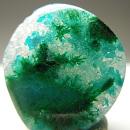|
|
||||||||||||||||
|
||||||||||||||||
|
||||||
|
|
|
|
Brochantite
(inclusions
in Quartz) |
|
| | |
| Discovered in 1824; IMA status: Valid (pre-IMA; Grandfathered) | ||
|
| ||
|
Chemistry |
|
|
| |
|
Cu4(SO4)(OH)6 | |
|
|
Copper Sulfate Hydroxide |
|
Molecular Weight: |
452.29 gm |
|
Composition: |
Copper |
56.20 % |
Cu |
70.35 % |
CuO |
|
|
Hydrogen |
1.34 % |
H |
11.95 % |
H2O |
|
|
Sulfur |
7.09 % |
S |
17.70 % |
SO3 |
|
|
Oxygen |
35.37 % |
O |
|
|
|
|
|
100.00 % |
|
100.00 % |
= TOTAL OXIDE |
|
|
|
||||
|
Classification |
|
|
| |
|
Sulfates | |
|
6/B.01-30 | |
|
|
7 : SULFATES (selenates, tellurates, chromates, molybdates, wolframates)
|
|
Related to: |
Two polytypes, both monoclinic, are known |
|
Varieties: |
None |
|
Synonyms: |
Blanchardite, Brogniartine (of Huot), ICSD 64688, IMA1980-s.p., Kamarezite, Koenigine, Königine, Konigite, PDF 43-1488, Waringtonite |
|
|
|
|
Crystal Data |
|
|
|
|
|
Crystals are typically thick prismatic to acicular, elongated along [001] or [010], to 5 cm; may be flattened [001]; about 40 forms known; in aggregates, druses, crusts, also massive, granular. |
|
|
On {100} with composition surface {100}, common. The twinned crystals are often symmetrical and pseudo-orthorhombic in appearance. |
|
|
|
|
|
Physical Properties |
|
|
|
|
|
Perfect on {100} |
|
|
Irregular/Uneven, Conchoidal |
|
|
Brittle |
|
|
3.5 - 4.0 |
|
|
3.97 (g/cm3) |
|
|
None |
|
|
Not Radioactive |
|
|
Other: |
Soluble in acids |
|
|
|
|
Optical Properties |
|
|
|
|
|
Emerald-green, blackish green, pale green; bluish green in transmitted light |
|
|
Transparent to translucent |
|
|
Vitreous, somewhat pearly on cleavages |
|
|
1.728 - 1.800 Biaxial ( - ) |
|
|
0.072 |
|
|
Medium; r < v |
|
|
Weak; Slight in shades of bluish green |
|
|
|
|
|
Occurances |
|
|
|
|
|
Geological Setting: |
Common in the oxidized zone of copper deposits, yet rarely an ore; formed under low acidity, principally in arid regions. |
|
Common Associations: |
Malachite, Azurite, Tenorite, Cuprite, Linarite, Caledonite, Cerussite, Atacamite, Chrysocolla, Cyanotrichite, iron oxides |
|
Common Impurities: |
n/a |
|
Type Locality: |
Mednorudyanskoye Cu Deposit, Nizhnii Tagil, Sverdlovskaya Oblast', Middle Urals, Urals Region, Russia |
|
Year Discovered: |
1824 |
|
View mineral photos: | |
|
|
|
|
More Information |
|
|
|
|
|
| |
|
|
|
|
Brochantite was named in 1824 by Serve-Dieu Abailard "Armand" Lévy in honor of André-Jean-François-Marie Brochant de Villiers (1772-1840), French geologist and mineralogist. Brochantite
distribution: In Russia, from the Mednorudyanskoye copper
deposit, near Nizhni Tagil, and at Gumeshevsk, southwest
of Yekaterinburg (Sverdlovsk), Ural Mountains. At Băiţa Mining District (Baita Bihor; Rézbánya),
Romania. From Rosas and Sa Duchessa, Sardinia, Italy.
In Germany, at the Clara mine, near Oberwolfach, Black
Forest. In England, numerous occurrences in Cornwall,
and at Roughton Gill, Cumbria. From Tsumeb, Namibia.
At Aïn-Barbar, Constantine, Algeria. In Australia,
at Broken Hill, New South Wales. From many occurrences
in Chile, as at Chuquicamata and Collahuasi, Antofagasta;
from Potrerillos, Atacama; and at Challacollo, Tarapacá.
In the USA, in Arizona, large crystals from Bisbee,
Cochise County, and at the Mammoth-St. Anthony mine,
Tiger, Pinal County; in the Mammoth mine, Tintic, Juab
County, Utah; at Bingham, Socorro County, New Mexico;
from the Cerro Gordo mine, Inyo County, California;
in the Douglas Hill and Mason Pass mines, Yerington
district, Lyon County, Nevada. Many other localities
are known. |
|
|
We
have not photographed our Brochantite
gems yet. Please
check back soon. |
